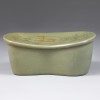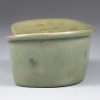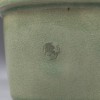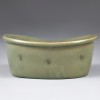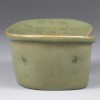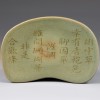작품 정보
윗면에 남북조 시인 소자현의 시 구절이 쓰여 있고, 측면에 규칙적인 간격으로 다섯 개의 문양이 있는 타원형 베개입니다.
몸체 전체적으로 빙렬과 기포가 있으며, 바닥면에 다섯 개의 지정흔(支釘痕)이 있습니다.
윗면과 바닥면 글씨의 해석은 다음과 같습니다.
<윗면>
樹中草 수중초
幸有靑袍色 행유청포색
聊因翠 료인취
幄凋 악조
雖間珊瑚蒂 수간산호체
非是 비시
合歡條 합환조
樹中草 나무 속에서 자란 풀
幸有靑袍色 다행이 푸른 도포 색을 띠고 있으나
聊因翠幄凋 무료하여서 비취색 장막처럼 시든다.
雖間珊瑚蒂 비록 산호 사이에 가시가 있는 듯하나
非是合歡條 아니다 바로 기쁨을 함께 함이로다
<바닥면>
郭茂倩督造 곽무천독조
元丰七䄹 원풍 7년(1084)
天章閣統錄 천장각통록
곽무천이 감독하여 제조한 것으로,
원풍 7년
천장각에 등록되었습니다.
- 곽무천: 송나라 운주(鄆州) 수성(須城) 사람으로, 자는 덕찬(德粲)입니다. 곽원명(郭源明)의 아들입니다. 원풍(元豊) 7년(1084)에 하남부법조참군(河南府法曹參軍)이 되었습니다. 음률에 정통했고, 한예(漢隸)를 잘 썼습니다. 『악부시집(樂府詩集)』을 저술했는데, 역대의 악부 가사를 수록한 책 중에서 가장 정리가 잘 된 저작으로, 해설이 정확하고 고증이 분명하여 악부의 집대성(集大成)으로 평가됩니다.
- 천장각: 진종(眞宗, 968~1022년)이 세운 장서각입니다.
전반적으로 '나무 속 풀(수중초)'을 세밀하게 묘사한 이 시는 자연미에 대한 추구와 깨달음, 생명과 자연의 섭리에 대한 깊은 생각을 담고 있습니다.
전체적으로 햇빛에 비친 풀잎의 청록색을 닮은 듯한 청유가 시유된 이 베개는 시의 의미를 한층 더 돋보이게 하며, 측면의 문양은 시에서 등장하는 떨어지는 풀잎을 닮았습니다.
━━━━━
青瓷枕呈椭圆形,枕面刻有南北朝诗人萧子显的诗句,枕侧一定间隔下以五个图案装饰。
整体有开片纹和气泡,底部有五个支钉痕。
枕面与底部文字解析如下:
<枕面>
樹中草
幸有靑袍色
聊因翠幄凋
虽间珊瑚蒂
非是合欢条
大意:
树中的小草,虽幸得青翠鲜亮的颜色,却因为隐藏于绿荫之下而逐渐枯萎。尽管生长于如珊瑚般珍贵的枝茎之间,它也并非能带来欢愉的合欢条。
<底部>
郭茂倩督造
元丰七年
天章阁统录
背景解析:
- 郭茂倩:宋代郓州须城人,字德粲,郭源明之子。元丰七年(1084年)为河南府法曹参军。精通音律,擅长汉隶,著有《乐府诗集》。此书被认为是历代乐府诗歌的集大成之作,考据详尽,解读精准。
- 天章阁:宋真宗(968-1022年)所建之皇家藏书阁。
整体描述:
这首《树中草》诗精细地描写了自然中的草木,以追求自然之美和对生命与自然规律的深入思考为主题。
枕面施仿似阳光照耀下绿草青翠色泽的青釉,进一步突出了诗意之美。而侧面的装饰图案,形似飘落的草叶,与诗中描绘的意象相呼应,呈现出极富自然美感的艺术造型。
━━━━━
This oval-shaped celadon pillow features an inscription of a poem by the Southern and Northern Dynasties poet Xiao Zixian on the upper surface.
The sides display five evenly spaced patterns. The pillow's entire body is characterized by crackling and small bubbles, while the base has five support marks left from the firing process.
Interpretations of the inscriptions on the upper and bottom surfaces:
Top Side
樹中草 (Shuzhongcao)
幸有靑袍色 (Xingyou Qingpao Se)
聊因翠幄凋 (Liaoyin Cuiwo Diao)
雖間珊瑚蒂 (Suijian Shanhu Di)
非是合歡條 (Feishi Hehuan Tiao)
Translation of the Poem:
Grass growing amidst the trees,
Fortunate to bear the color of a green robe.
In its solitude, it withers like a jade canopy.
Though adorned with coral thorns,
It is not the branch of joyous union.
Bottom Side
郭茂倩督造 (Guo Maoqian Duzao)
元丰七年 (Yuanfeng Year 7 - 1084)
天章閣統錄 (Tianzhangge Tonglu)
Translation of the Bottom Inscription:
Supervised by Guo Maoqian,
Year 7 of Yuanfeng (1084),
Registered in the Tianzhang Pavilion.
Context and Historical Notes:
Guo Maoqian: A scholar from the Song Dynasty, originally from Xucheng, Yanzhou. His courtesy name was Dechan, and he was the son of Guo Yuanming. In 1084 (Yuanfeng Year 7), he was appointed as an assistant magistrate in Henan Prefecture. Renowned for his expertise in music and calligraphy, Guo compiled the Anthology of Yuefu Poetry (Yuefu Shiji), a seminal work cataloging lyrical pieces from various dynasties. The anthology is praised for its precise commentary and meticulous verification, serving as a comprehensive record of Yuefu ballads.
Tianzhang Pavilion: A library established during the reign of Emperor Zhenzong (968–1022) for the collection and preservation of valuable manuscripts.
Artistic and Symbolic Significance:
The poem "Grass among Trees" delicately portrays the beauty of nature and reflects profound philosophical thought about life, nature's principles, and human understanding of the natural world. The celadon glaze, reminiscent of sunlit green foliage, enhances the poem's essence. The side patterns mimic falling leaves, aligning with the poem's imagery and further emphasizing the connection between art, poetry, and nature.
CONDITION
NOTICE
상담/문의 : 02- 730-5601 / 02- 730-7566

